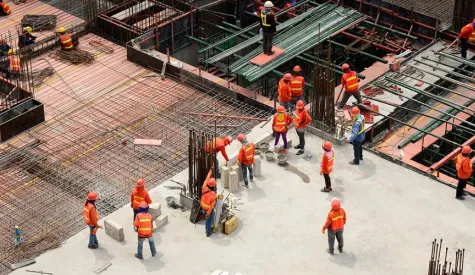Unprotected Wall Openings

What’s the hazard here? Both employees are exposed to a fall hazard. Both, really? It seems obvious the person standing on the window framing is more at risk of falling, however, the person on the interior is exposed to a fall hazard as well. The situation we have here is called a wall opening and the wall opening (in this case, a window) is creating a fall hazard. Any time an employee is exposed to a fall hazard of 4-feet or more in a General Industry setting or 6-feet or more in a construction setting, the employees need to be protected from falling. It’s difficult to tell if this is a general industry setting or a construction setting. A general industry example would be if this is an existing building and the glass window is being replaces like with like. In a construction example, this could be new construction of a new building. By proximity and because the window opening is not adequately guarded nor is there another visible method of preventing falls, both employees have a fall exposure.
How can this hazard be corrected? A guardrail system, safety net system or a personal fall arrest system could be used to protect employees exposed to this hazard. If a guardrail system is used, then the top rail height shall be 42 inches (1.1 m) plus or minus 3 inches (8 cm) above the walking/working level. Mid-rails, screens, mesh, intermediate vertical members, or equivalent intermediate structural members shall be installed between the top edge of the guardrail system and the walking/working surface when there is no wall or parapet wall at least 21 inches (53 cm) high. Take a closer look at the photo again. If a guardrail system were used, a top-rail would need to be installed at a height of 42-inches. Then, if the window framing where the employee is standing is at least 21-inches high, it could be used as the mid-rail.
Any laws around this? Yes! In a construction application, it is: 29 CFR 1926.501(b) (14) which states the following: "Wall openings." Each employee working on, at, above, or near wall openings (including those with chutes attached) where the outside bottom edge of the wall opening is 6 feet (1.8 m) or more above lower levels and the inside bottom edge of the wall opening is less than 39 inches (1.0 m) above the walking/working surface, shall be protected from falling by the use of a guardrail system, a safety net system, or a personal fall arrest system.
In a general industry setting it is: 1910.28(b) (7) Openings. The employer must ensure that each employee on a walking-working surface near an opening, including one with a chute attached, where the inside bottom edge of the opening is less than 39 inches (99 cm) above that walking-working surface and the outside bottom edge of the opening is 4 feet (1.2 m) or more above a lower level is protected from falling by the use of:
Additionally, the term “opening” is defined in 29 CFR 1926.500(b) as a gap or void 30 inches (76 cm) or more high and 18 inches (48 cm) or more wide, in a wall or partition, through which employees can fall to a lower level. The same definition is found in the general industry regulations at 29CFR 1910.21(b).
Conversation Starters: Get out your tape measures and start a guard rail measuring campaign in your work environments. This is a work activity your safety committee or supervisors in a work area could do as a way to identify deficiencies or areas in need of guarding. Additionally, use this information as a guide for scheduled construction or maintenance work as a reminder of hazards of which to be aware. Remember, talk with your employees! Ask them about routine and non-routine jobs where they might be exposed to a fall height that you don’t know about, this is a good way to view certain job tasks through a safety lens. Good luck!
Learn more about OSHA construction standards


